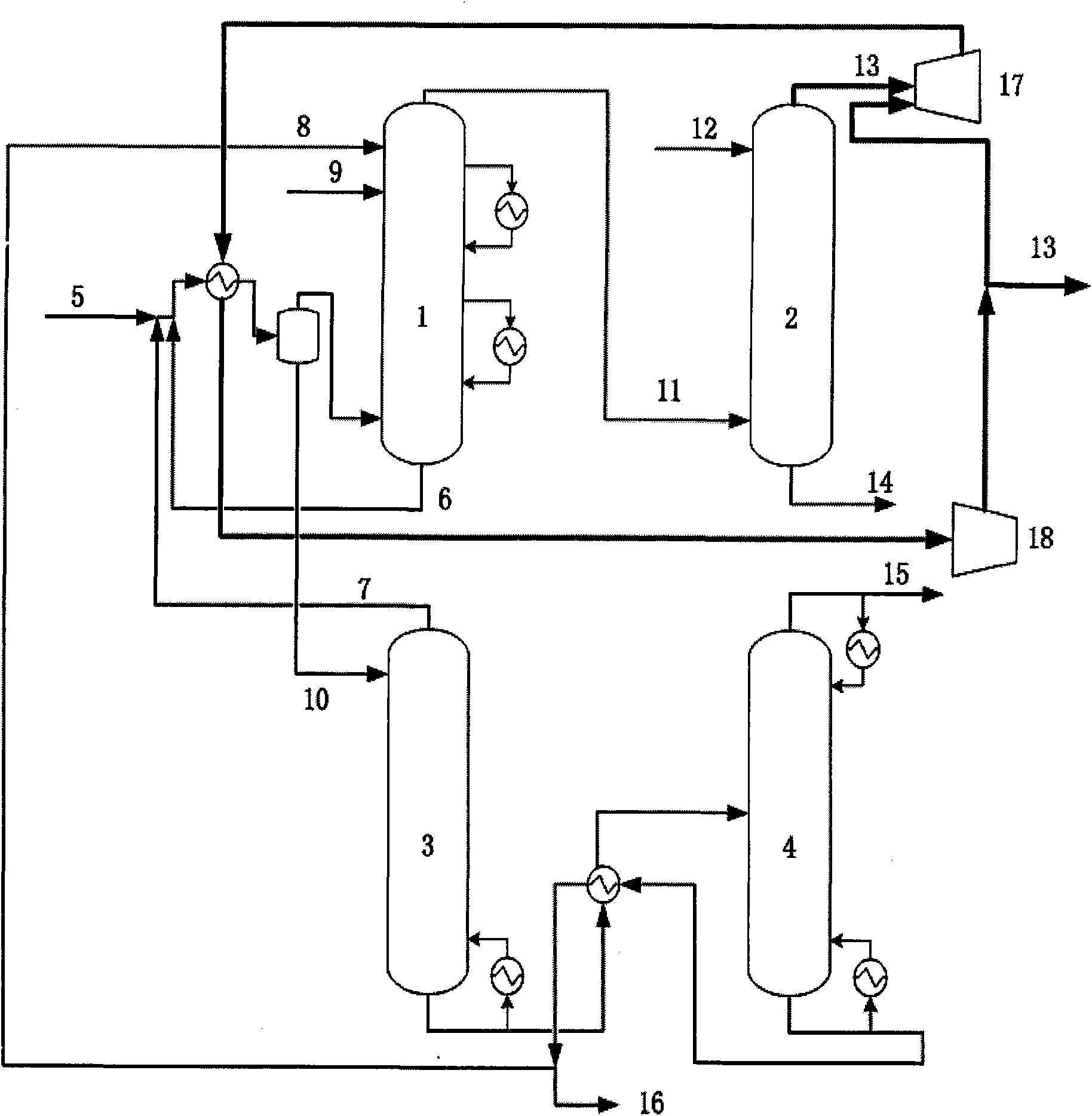Method for improving yield of liquefied gas by downstream separation system of catalytic cracking device
A catalytic cracking unit and separation system technology, applied in the downstream separation system of the catalytic cracking unit to improve the yield of liquefied gas, can solve the problems of increasing the load energy consumption of the absorption tower and desorption tower, unqualified quality, excessive desorption of the desorption tower, etc.
- Summary
- Abstract
- Description
- Claims
- Application Information
AI Technical Summary
Problems solved by technology
Method used
Image
Examples
Embodiment 1
[0019] A refinery with a catalytic processing capacity of 650,000 tons per year is used for simulation, the compressed rich gas capacity is 14241 kg / h, and the naphtha flow rate is 23545 kg / h. This process adopts the desorption tower cold feed process. The compressed rich gas from the catalytic cracking main fractionation tower, the rich absorption oil and the stripped gas from the top of the stripping tower are mixed at about 62°C. The dry gas at the top of the reabsorption tower first passes through the expander until the outlet pressure is 200kpa, and the temperature drops to -38.9°C, and then exchanges heat with the mixture of compressed rich gas, rich absorption oil and desorbed gas, and the mixture is 30.2 after heat exchange ℃, the temperature of the dry gas rises to 25.2°C, and then compressed by the compressor to a pressure of 1500kpa, part of it is discharged from the system as a product, and the rest is recycled back to the inlet of the expander, with a circulation ...
Embodiment 2
[0029] A refinery with a catalytic processing capacity of 650,000 tons per year is used for simulation, the compressed rich gas capacity is 14241 kg / h, and the naphtha flow rate is 23545 kg / h. This process adopts the desorption tower cold feed process. The compressed rich gas from the catalytic cracking main fractionation tower, the rich absorption oil and the stripped gas from the top of the stripping tower are mixed at about 62°C. The dry gas at the top of the reabsorption tower first passes through the expander until the outlet pressure is 250kpa, and the temperature drops to -30.7°C, and then exchanges heat with the mixture of compressed rich gas, rich absorption oil and desorbed gas, and the mixture is 32.5 after heat exchange ℃, the temperature of the dry gas rises to 27.5°C, and then compressed by the compressor to a pressure of 1500kpa, part of it is discharged from the system as a product, and the rest is recycled back to the inlet of the expander with a circulation r...
Embodiment 3
[0040] A refinery with a catalytic processing capacity of 650,000 tons per year is used for simulation, the compressed rich gas capacity is 14241 kg / h, and the naphtha flow rate is 23545 kg / h. This process adopts the desorption tower cold feed process. The compressed rich gas from the catalytic cracking main fractionation tower, the rich absorption oil and the stripped gas from the top of the stripping tower are mixed at about 62°C. The dry gas at the top of the reabsorption tower first passes through the expander until the outlet pressure is 300kpa, and the temperature drops to -23.7°C, and then exchanges heat with the mixture of compressed rich gas, rich absorption oil and desorbed gas, and the mixture is 34.5 after heat exchange ℃, the dry gas temperature rises to 29.5°C, and then compressed by the compressor to a pressure of 1500kpa, part of it is discharged from the system as a product, and the rest is recycled back to the inlet of the expander, with a circulation rate of...
PUM
 Login to View More
Login to View More Abstract
Description
Claims
Application Information
 Login to View More
Login to View More - R&D
- Intellectual Property
- Life Sciences
- Materials
- Tech Scout
- Unparalleled Data Quality
- Higher Quality Content
- 60% Fewer Hallucinations
Browse by: Latest US Patents, China's latest patents, Technical Efficacy Thesaurus, Application Domain, Technology Topic, Popular Technical Reports.
© 2025 PatSnap. All rights reserved.Legal|Privacy policy|Modern Slavery Act Transparency Statement|Sitemap|About US| Contact US: help@patsnap.com

